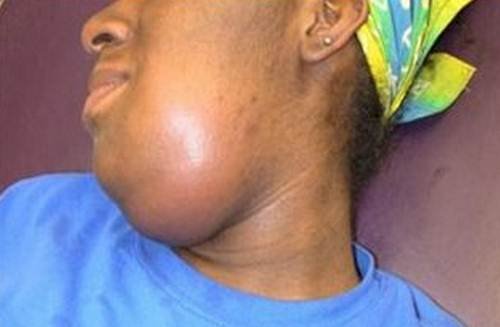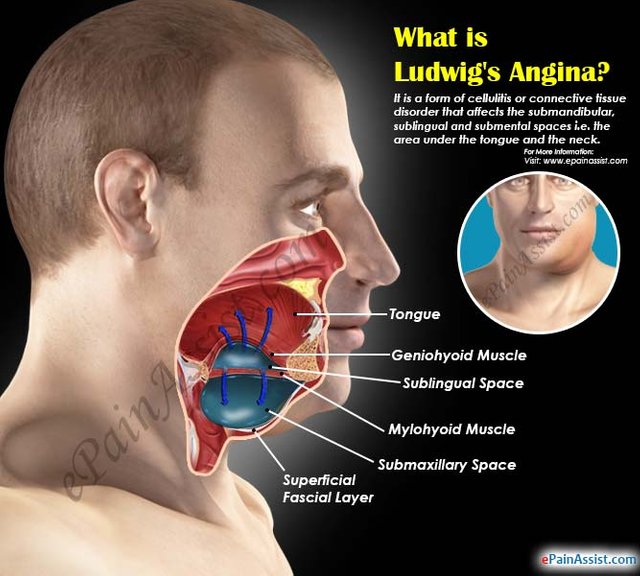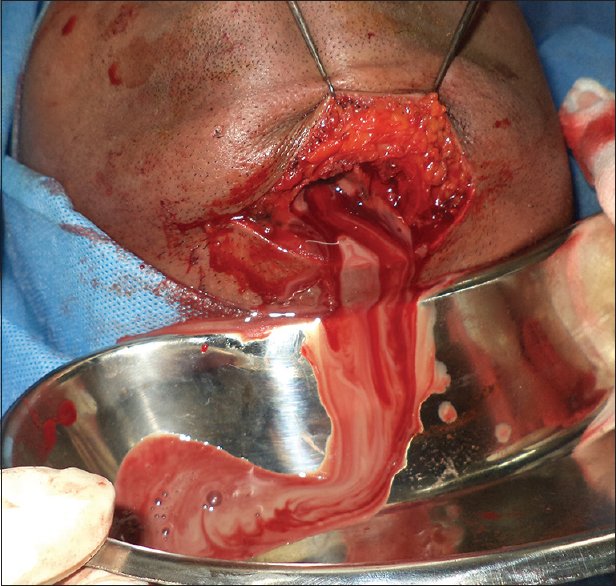LUDWIG'S ANGINA - what i found out today at the dental clinic
Introduction
Ludwig’s Angina also known as Angina Ludovici, is a known, yet a rare surgical emergency that is potentially life threatening unless early recognized and aggressively treated. Named after the German physician, Karl Friedrich Willhelm von Ludwig, Ludwig's angina is characterized as a rapidly progressive gangrenous cellulitis of the soft tissues of the neck and floor of the mouth.
Causes
Ludwig's angina is a type of skin infection that occurs on the floor of the mouth, under the tongue. It often develops after an infection of the roots of the teeth (such as tooth abscess), poor dental hygiene, trauma or lacerations in the mouth, a recent tooth extraction
image source:http://www.urjd.org/articles/2015/5/2/images/UnivResJDent_2015_5_2_82_157741_f8
Symptoms
Symptoms include:
Breathing difficulty
Difficulty swallowing
Drooling
Unusual speech (sounds like the person has a "hot potato" in the mouth)
Tongue swelling or protrusion of the tongue out of the mouth
Fever
Neck pain
Neck swelling
Redness of the neck
Other symptoms that may occur with this disease:
Weakness, fatigue, excess tiredness
Confusion or other mental changes
Earache
Exams and Tests
The dentist will do an exam of the neck and head to look for redness and swelling of the upper neck, under the chin.
The swelling may reach to the floor of the mouth. The tongue may be swollen or out of place.
The patient may need a CT scan of the neck. A sample of the fluid from the tissue may be sent to the lab to test for bacteria.
Management
Early recognition of the disease is of paramount importance. The Mainstay of treatment is to secure the airway, antibiotic therapy, and often surgical drainage by OMFS or ENT.
Medical management of these patients should begin promptly with intravenous access, fluid resuscitation, and administration of IV antibiotics. Antibiotic therapy should be administered empirically and tailored to culture and sensitivity results.

image source: http://ehealthwall.com/wp-content/uploads/2012/01/Gross-swelling-at-submandibular-region-in-ludwigs-angina
Computed tomography is the imaging modality of choice for the diagnosis of deep neck space infections.
Airway compromise should not be taken lightly as these infections may progress rapidly. Cases described as “perilous airway”. Direct compression of the airway may arrive from the displacement of the tongue posteriorly or secondary to laryngeal edema. These patients should be managed as presumed difficulty airway and are challenging with even when in a relatively controlled O.R. environment. In several studies, up to 75% of patients with Ludwig’s angina require the tracheostomy. In a study reviewing 20 attempts at oral intubation, 11 were unsuccessful, failed airways requiring the emergent tracheostomy. Involve our colleagues in Anesthesia and ENT early.
Many deep infections of the head and neck require surgical intervention in the form of incision and drainage. Many would argue that when there is an abscess in the deep neck, surgical drainage is mandatory. Depending on the series, surgical drainage is required in 10% to 83% of patients who present with deep neck space infections.

image source: https://www.epainassist.com/images/what-ludwigs-angina
Treatment
If the swelling blocks the airway, the patient needs to get emergency medical help right away. A breathing tube through the mouth or nose and into the lungs to restore breathing. The patient may need to have surgery called a tracheostomy that creates an opening through the neck into the windpipe.
Antibiotics are given to fight the infection. They are usually given through a vein until symptoms go away. Antibiotics taken by mouth may be continued until tests show that the bacteria have gone away.
Dental treatment may be needed for tooth infections that cause Ludwig's angina.
Surgery may be needed to drain fluids that are causing the swelling.
REFERENCES
- Saifeldeen K, Evans R. Ludwig's angina. Emerg Med J. 2004;21:242–3. [PMC free article] [PubMed]
- Bansal A, Miskoff J, Lis RJ. Otolaryngologic critical care. Crit Care Clin. 2003;19:55–72. [PubMed]
- Moreland LW, Corey J, McKenzie R. Ludwig's angina. Report of a case and review of the literature. Arch Intern Med. 1988;148:461–6. [PubMed]
- Spitalnic SJ, Sucov A. Ludwig's angina: Case report and review. J Emerg Med. 1995;13:499–503. [PubMed]
- Fischmann GE, Graham BS. Ludwig's angina resulting from the infection of an oral malignancy. J Oral Maxillofac Surg. 1985;43:795–6. [PubMed]
- Owens BM, Schuman NJ. Ludwig's angina. Gen Dent. 1994;42:84–7. [PubMed]
- Owens BM, Schuman NJ. Ludwig's angina: Historical perspective. J Tenn Dent Assoc. 1993;73:19–21. [PubMed]
- LeJeune HB, Amedee RG. A review of odontogenic infections. J La State Med Soc. 1994;146:239–41. [PubMed]
- Melio FR. Upper respiratory tract infections. In: Marx JA, Hockberger RS, Walls RM, et al, eds. Rosen's Emergency Medicine: Concepts and Clinical Practice . 7th ed. Philadelphia, Pa: Mosby Elsevier;2009:chap 73.
- Christian JM. Odontogenic infections. In: Cummiongs CW, Flint PW, Haughey BH, et al. Otolaryngology: Head & Neck Surgery. 5th ed. Philadelphia, Pa: Mosby Elsevier;2010:chap 12.
- Boscolo-Rizzo P, Da Mosto MC. Submandibular space infection: a potentially lethal infection. Int J Infect. Dis 2009; 13:327.
- F. Wang, W.R. Kuo, S.M. Tsai, K.J. Huang. Characterizations of life-threatening deep cervical space infections: a review of one hundred ninety-six cases. Am J Otolaryngol, 24(2003), pp. 111-117.
- T. Huang, T.C. Liu, P.R. Chen, F.Y. Tseng, T.H. Yeh, Y.S. Chen. Deep neck infection: analysis of 185 cases. Head Neck; 26(2004), pp. 854-860.
- Srirompotong, T. Art-Smart. Ludwig’s angina: a clinical review. Eur Arch Otorhinolaryngol, 260(2003), pp. 401-403.
Osborn T.M., Assael LA, Bell RB. Deep space neck infection: principles of surgical management. Oral Maxillofac Surg Clin North Am. 2008 Aug;20(3):353-65.
